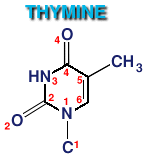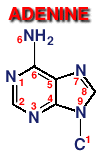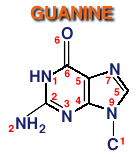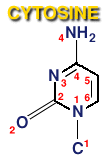Home » Xanetics Research
Xanetics
Welcome to Xanetics Research, a component of Xanatos Enterprises. Xanetics is a private and organization devoted to research that shows promise for extending the healthy human lifespan. In 1996, several unprecedented breakthroughs in genetics research appeared on the scene, among these was the research spearheaded by Geron Corp., in Menlo Park, CA, (NASDAQ: GERN) into the function of Telomeres and Telomerase and their controlling effect on cellular "senescence" or cellular aging.
What are Telomeres?
 Telomeres are structures found at the ends of the chromosomes in every
cell in our bodies (and most all other life on Earth). These structures consist of a
repeated sequence (roughly 9,000 to 10,000 in a human at conception) of chemicals (Thymine,
Adenine, and Guanine- see the images to the right). Telomeres' function may be thought
of as "buffers" to protect the genetic coding information of the inner DNA. Until
fairly recently, these structures were considered "extraneous" material, and
not given much notice. In the 1980's, however, a relationship was noted between
telomere length and age of the individual. Further findings showed that those with
the rapid aging disease of progeria exhibited severly shortened, or missing
telomeres. Researchers began to theorize that they had found the cellular aging clock,
and the race was on.
Telomeres are structures found at the ends of the chromosomes in every
cell in our bodies (and most all other life on Earth). These structures consist of a
repeated sequence (roughly 9,000 to 10,000 in a human at conception) of chemicals (Thymine,
Adenine, and Guanine- see the images to the right). Telomeres' function may be thought
of as "buffers" to protect the genetic coding information of the inner DNA. Until
fairly recently, these structures were considered "extraneous" material, and
not given much notice. In the 1980's, however, a relationship was noted between
telomere length and age of the individual. Further findings showed that those with
the rapid aging disease of progeria exhibited severly shortened, or missing
telomeres. Researchers began to theorize that they had found the cellular aging clock,
and the race was on.
 As research has proven out, when cells divide (which is the normal
method that the body uses to rejuvenate and replace tired, worn out cells), a small
segment of the telomere strand is lost with each successive division. When, after
a lifetime of cellular divisions, the telomeres are exhausted, and the "main"
DNA string is exposed, the cell receives a chemical signal. This signal tells the cell
that if it divides again, it will express a corrupt DNA pattern, and the cell ceases to
divide again, despite the presence of any growth
factors. Eventually, as the cell ages well past its normal division point, it breaks
down, and is not replaced. Over time, as more and more cells begin to "wink out"
in this fashion, and the remaining cells have to fill in and do the job of their missing
co-workers, tissues begin to thin out, creating many of the obvious effects of aging. Not
so obvious is the fact that the weakened tissues now become potential targets for the
opportunistic diseases of aging.
As research has proven out, when cells divide (which is the normal
method that the body uses to rejuvenate and replace tired, worn out cells), a small
segment of the telomere strand is lost with each successive division. When, after
a lifetime of cellular divisions, the telomeres are exhausted, and the "main"
DNA string is exposed, the cell receives a chemical signal. This signal tells the cell
that if it divides again, it will express a corrupt DNA pattern, and the cell ceases to
divide again, despite the presence of any growth
factors. Eventually, as the cell ages well past its normal division point, it breaks
down, and is not replaced. Over time, as more and more cells begin to "wink out"
in this fashion, and the remaining cells have to fill in and do the job of their missing
co-workers, tissues begin to thin out, creating many of the obvious effects of aging. Not
so obvious is the fact that the weakened tissues now become potential targets for the
opportunistic diseases of aging.
 Now that the mechanisms of cellular aging had been discovered, a mechanism
to prevent this needed to be found. And, as it turns out, it was found in the relatively
immortal nature of cancer cells. Cancer cells are cells whose genetic code is defective,
AND that have somehow switched on an enzyme called Telomerase. The function of
Telomerase is to examine every step of the DNA sequence in a cell prior to a cellular
division, and then to verify, and repair if necessary, the new copies after division.
This verification and repair process does not occur in normal, healthy human cells (with
some exceptions, such as in male reproductive cells, and certain intestinal cells).
Telomerase will, when it reaches the end of the DNA strand, detect the missing end piece
of the telomere, rebuild it, and reattach it to the strand. In effect, it resets the
clock with every successive division.
Now that the mechanisms of cellular aging had been discovered, a mechanism
to prevent this needed to be found. And, as it turns out, it was found in the relatively
immortal nature of cancer cells. Cancer cells are cells whose genetic code is defective,
AND that have somehow switched on an enzyme called Telomerase. The function of
Telomerase is to examine every step of the DNA sequence in a cell prior to a cellular
division, and then to verify, and repair if necessary, the new copies after division.
This verification and repair process does not occur in normal, healthy human cells (with
some exceptions, such as in male reproductive cells, and certain intestinal cells).
Telomerase will, when it reaches the end of the DNA strand, detect the missing end piece
of the telomere, rebuild it, and reattach it to the strand. In effect, it resets the
clock with every successive division.
The work of Geron Corp., and others, including the Whitehead Institute in Boston, MA., has been to discover methods by which the enzyme Telomerase, which is an enzyme that is able to be produced by human cells, but is not normally, may be "switched on", to allow healthy cells to continue to reproduce indefinitely. This research has been successful in-vitro on samples from a number of human tissues. Cells which have a normal replicative lifespan of 50 to 100 generations are still humming along at more that double or triple their natural lifespan, with no sign of mutation or cancerous deviations. The process is not as hard as one might imagine, and within 5 to 10 years (depending on how long the FDA takes in this country to approve its use), clinical applications should begin to enter the marketplace. Major pharmaceutical corporations such as Upjohn and Pharmacia have poured large sums of money into developing this and its sister research, turning OFF telomerase stop cancer in its tracks, in an effort to bring the fruits of this labor into our lives.
While there is no way of knowing exactly how long this breakthrough will extend our lives, if we have discovered this much now, the extra time it buys us may allow us to live with excellent health many, many decades beyond what we would have lived without it, and perhaps past the point of the next significant breakthrough in extending the human lifespan. It is a worthy point of study.
TELOMERE BASICS
Basic Nucleotide Units Found in DNA, including TELOMERES

C5H6N2O2

C5H3N4NH2

C5H5N5O
TELOMERES in human beings are a repeating sequence of three of these
nucleotide units: Thymine (T), Adenine (A), and Guanine (G), in the sequence:

Each base unit is connected to a sugar via a beta glycosyl linkage. Both ends of the strands contain telomeres, and both the 3' and 5' strand contain these end sequences. The normal bonding pairs Adenine with Thymine, and Guanine with Cytosine, in a relationship known as complementarity.
 The flip side of Telomeres is Telomerase, a combination of RNA (designated
hTR for Human Telomerase RNA) and a protein (hTRT, for Human Telomerase Reverse
Transcriptase). Telomerase directs the synthesis of the TTAGGG sequence. In effect,
it contains a template of complementarity (AAUCCC) that allows it to stamp out
telomeres much like a cookie cutter.
The flip side of Telomeres is Telomerase, a combination of RNA (designated
hTR for Human Telomerase RNA) and a protein (hTRT, for Human Telomerase Reverse
Transcriptase). Telomerase directs the synthesis of the TTAGGG sequence. In effect,
it contains a template of complementarity (AAUCCC) that allows it to stamp out
telomeres much like a cookie cutter.
Now, you might be asking "What can I do in the meantime to keep my body healthy while I wait to have my telomeres extended?". Well, eat healthy, get good exercise, have a good outlook on life, and take lots of HIGH QUALITY vitamins (especially antioxidants) to slow existing damage due to free radicals, homocysteine, etc. Check out The Life Extension Foundation, (http://www.lef.org) where you can read about the latest life extension vitamins and drugs, as well as research on telomeres and other life-extending therapies.
You may also visit Geron Corporation, (http://www.geron.com), spearheading this research. There you will find extensive and informative writeups on their exciting research.
If you are familiar with searching the Human Genome Databases, try NCBI (http://www.ncbi.nlm.nih.gov), and see if you can discover the next breakthrough in life extension and novel genetic therapeutics...
PO Box 170, Wilbraham, MA 01095-0170, xanatos@xanatos.com.
All rights reserved in all media. Xanatos™ is a registered trademark with the U.S. Patent and Trademark Office.
Please review the FAQ and Legal pages.